
12 UserVoice Alternatives & Competitors For Managing Customer Feedback
UserVoice is a product management and customer support tool that allows businesses and product teams to build a suggestions/ideas portal for their customers or users to submit feature ideas. They were the first to pioneer the notion of idea voting boards.
Even though they've been in the industry for a while now, their software isn't defensible and unique. At least, it's not worth the massive price tag it comes with.
It might not be the best choice for most companies. With a dated interface and complicated user experience bloated with features, UserVoice is an expensive option, so many businesses shy away.
If you are looking for an affordable and user-friendly UserVoice alternative, we've compiled a list of comparable, if not better, tools than UserVoice. We recommend these 12 excellent customer feedback tools with feature voting and their pros and cons.
12 Best UserVoice Alternatives & Competitors
- Rapidr
- Aha
- Productboard
- Pendo
- UseResponse
- UserTesting
- Prodpad
- ProductPlan
- Mopinion
- Qualaroo
- Hotjar
- Podium
But first, let's look at UserVoice features and capabilities, so we have a common yardstick to compare user feedback software in this list.
What is UserVoice?
UserVoice was launched in 2008; the service is said to have many customers worldwide and caters to enterprise companies that want to gather customer feedback, process support requests, and increase customer satisfaction.
With UserVoice, companies can create feedback boards for customers to share their opinions with the company and rate various products or services.
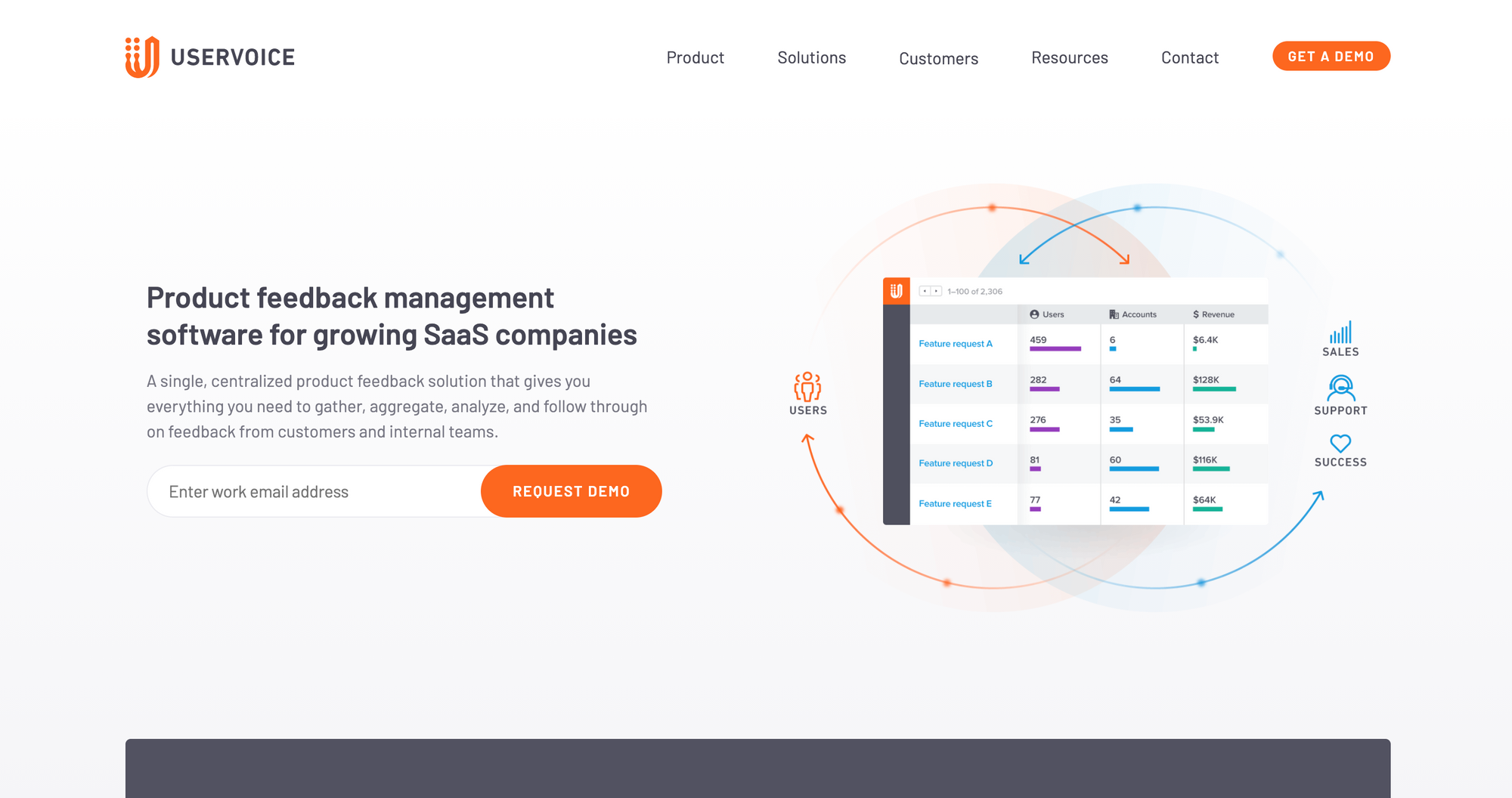
You can create a web feedback portal with a dedicated domain and embed a sidebar feedback button on your apps like Slack and Zendesk.
What is UserVoice Used For?
UserVoice is used for customer feedback management and idea and feature request voting. It also includes a hosted community feedback portal, an in-app feedback widget, and NPS surveys. They're mainly focused on enterprise-level companies like Microsoft.
Is UserVoice Free? How much does UserVoice cost?
No, UserVoice isn't free. UserVoice is enterprise software that starts at a whopping $799/ user /month with an annual agreement billed quarterly.
Pros of UserVoice
- UserVoice provides complete feedback software that gathers data from its customer base, analyzes it, and then presents it to them to make informed decisions about what should be improved or changed.
- UserVoice creates a feedback loop by providing forum software enabled with roadmap functionality.
- UserVoice has streamlined communication with customer-facing and product teams and keeps all product feedback in one location to increase transparency.
- They allow product teams to see how many customers requested a particular feature and its importance to their business goals. They allow segmentation and create cohorts for different types of users.
Cons of UserVoice
- UserVoice was built in 2008, and the user interface shows. Every simple task is complicated, challenging to navigate, and has a steep learning curve.
- Other than not being an affordable option, you would have to talk to a salesperson to get a good deal.
- Time-consuming and complicated onboarding requires much learning to understand the functionality, complete the setup, and collect user feedback.
Best UserVoice Alternatives For Managing Customer Feedback
1. Rapidr
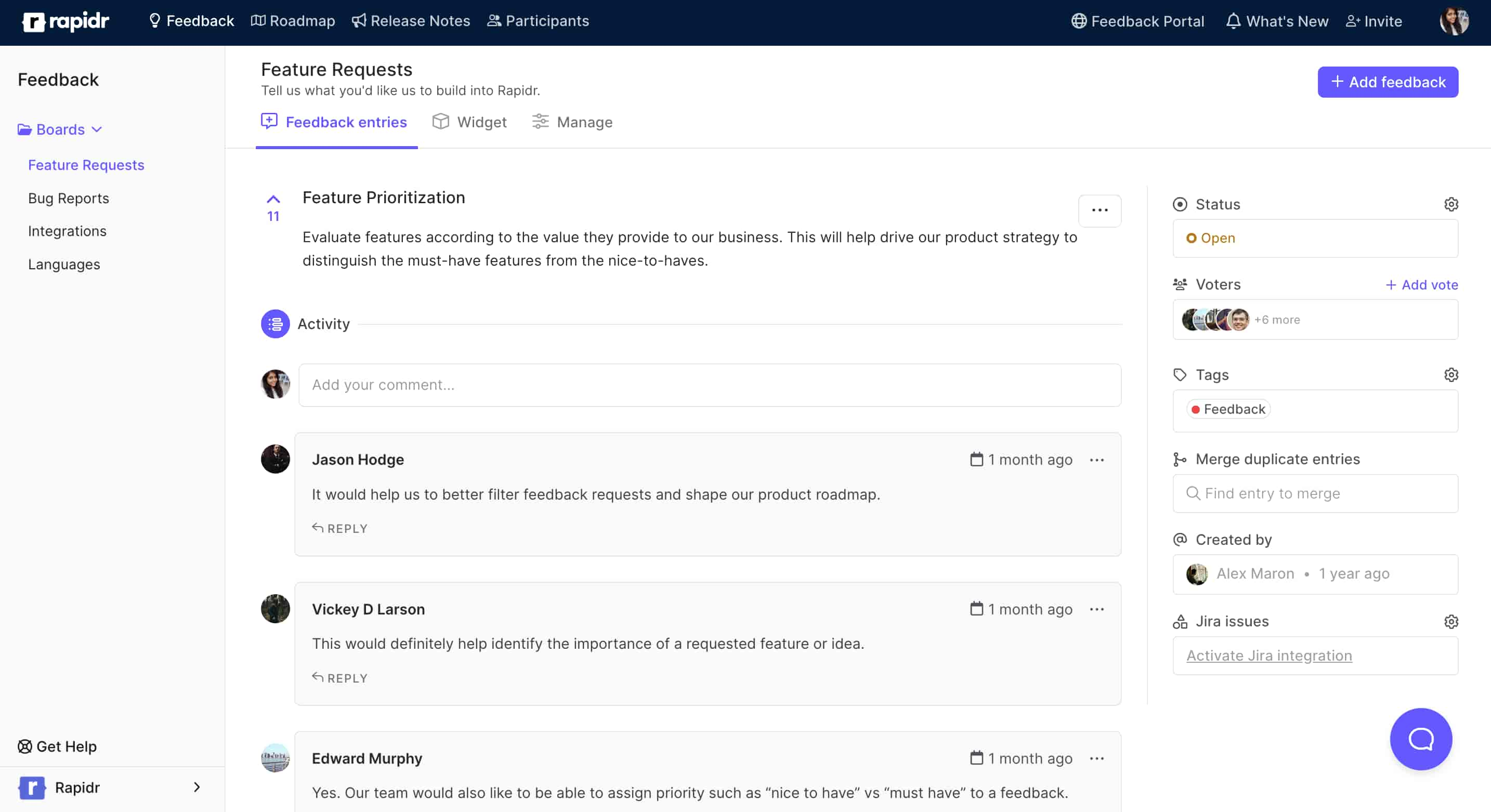
Rated: 4.5/5
Rapidr helps product teams understand what customers need by tracking feature requests and ideas, analyzing & prioritizing what to build next, creating a roadmap backed by customer insights, and communicating new features with release notes.
Understanding customers begins by collecting their feedback in a centralized app. Rapidr helps you capture product ideas, requests, and feedback from colleagues and customers with their customer portal and in-app widget.
Next, for analyzing and prioritizing the roadmap based on customer insights, Rapidr helps you slice and dice feedback by customer attributes and sorting by votes.
Lastly, use the most critical feedback to inform your roadmap and let your customers know what's new with release notes.
Pros of Rapidr
- Rapidr is an end-to-end feedback solution, so you don't have to glue together multiple apps yourself to close the feedback loop. By choosing Rapidr, you get feedback collection, roadmap software, and release notes software – all in one place.
- Rapidr is one of the most reasonable and cost-effective solutions that offer excellent value for money stacked against the other enterprise options on this list. Rapidr's pricing is based on the value you derive from the software instead of per-seat pricing.
- Rapidr's customer portal gives your users a persistent place to come and leave their ideas and requests. You can create multiple feature voting boards for every use-case or product vertical.
- Rapidr is built to support varying workflows and to match different product development terminology across companies. It's made to be customizable from day one.
- Rapidr can be fully white-labeled. White-labeling removes the "Powered by Rapidr" link from your feedback portal and emails, which means no visible branding from Rapidr.
Cons of Rapidr
- Rapidr has a few integrations, including Hubspot, Jira, Slack, Intercom, and Zapier, at the time of writing, but many are on the way. They track integrations on their public feedback board.
- Rapidr is relatively new, and many features are still underway. But with features rivaling UserVoice with a reasonable pricing plan, it's an excellent option for anyone looking for a UserVoice alternative.
Reviewers say that compared to UserVoice, Rapidr is:
The good parts:
- Cost-effective and inexpensive. Plans start from $49/mo.
- Modern and well-designed interface.
- Easy to use.
- Better at support.
- Self-service
- Quick to set up and to run.
The bad parts:
- SOC2 is not available.
Rapidr has changed the way we collect and manage feedback from our users. It helped us to create a single point of entry for all feedback requests across our product and avoid using huge spreadsheets and slack channels. It also helps keep our users and teammates in the loop as we make decisions for the product. - Daniel Wolken (Founder)
Read more: Compare UserVoice vs Rapidr.
2. Aha! Ideas
Rated: 4.1/5
Aha! is a roadmapping software. It allows us to set strategy and KPIs, crowdsource and manage ideas, and manage features with a Kanban board and Gantt charts. Aha! empowers product managers to understand the why, when, and what of products and create product portfolios with schedules, goals, release strategies, and more.
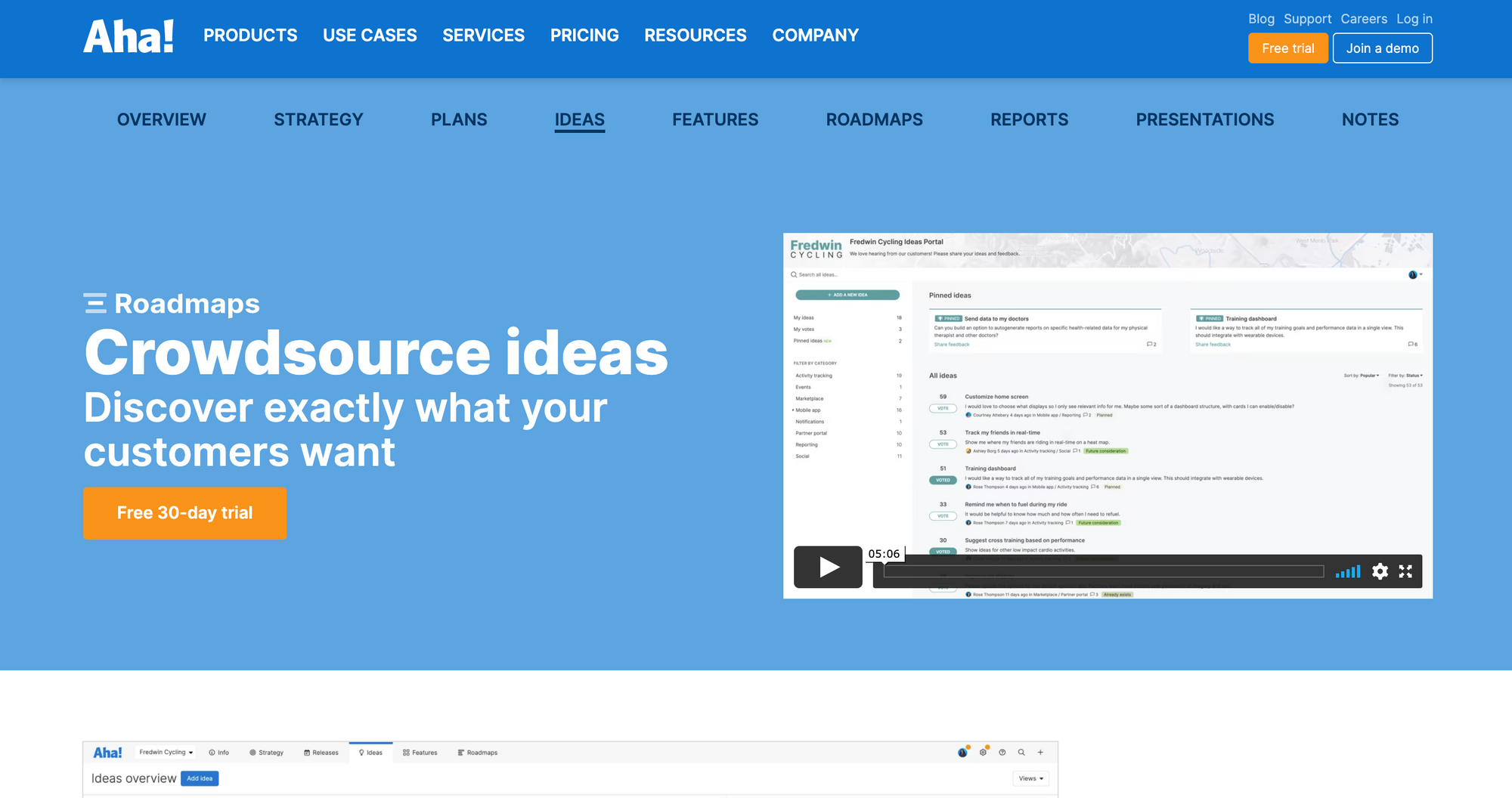
Pros of Aha
- Aha provides all product management facilities in one tool: requirement gathering, epic and user story breakdown, roadmap, backlog management, etc.
- Aha can be a sophisticated tool that's very flexible and configurable, so it requires a little while to get fluent with everything it may do and be aware of the best workflow patterns.
- Aha is focused on high-level strategic planning instead of a detailed project and task planning to achieve strategy and roadmap features with multiple customizable reports.
- Aha, roadmaps work way better as a roadmapping tool than Aha ideas used for idea management. It is excellent for creating Kanban boards and Gantt charts.
Cons of Aha
- Aha is a roadmap tool first and a feedback tool second. As a result, configuring it feels like a chore.
- They have per-seat pricing, so you'd need to pay for each teammate you bring to the platform. They offer scaled plans to larger businesses and provide multiple product managers access.
Reviewers say that compared to UserVoice, Aha is:
The good parts:
- Better at meeting requirements.
- More features.
- Self-service.
The bad parts:
- More expensive.
- Dated interface design.
3. Productboard
Rated: 4.3/5
Productboard is a project management tool that captures problems, feedback, and user research, organizes feature ideas, plans releases, and shares beautiful interactive roadmaps. It consolidates ideas from customers into a prioritized roadmap based on data.
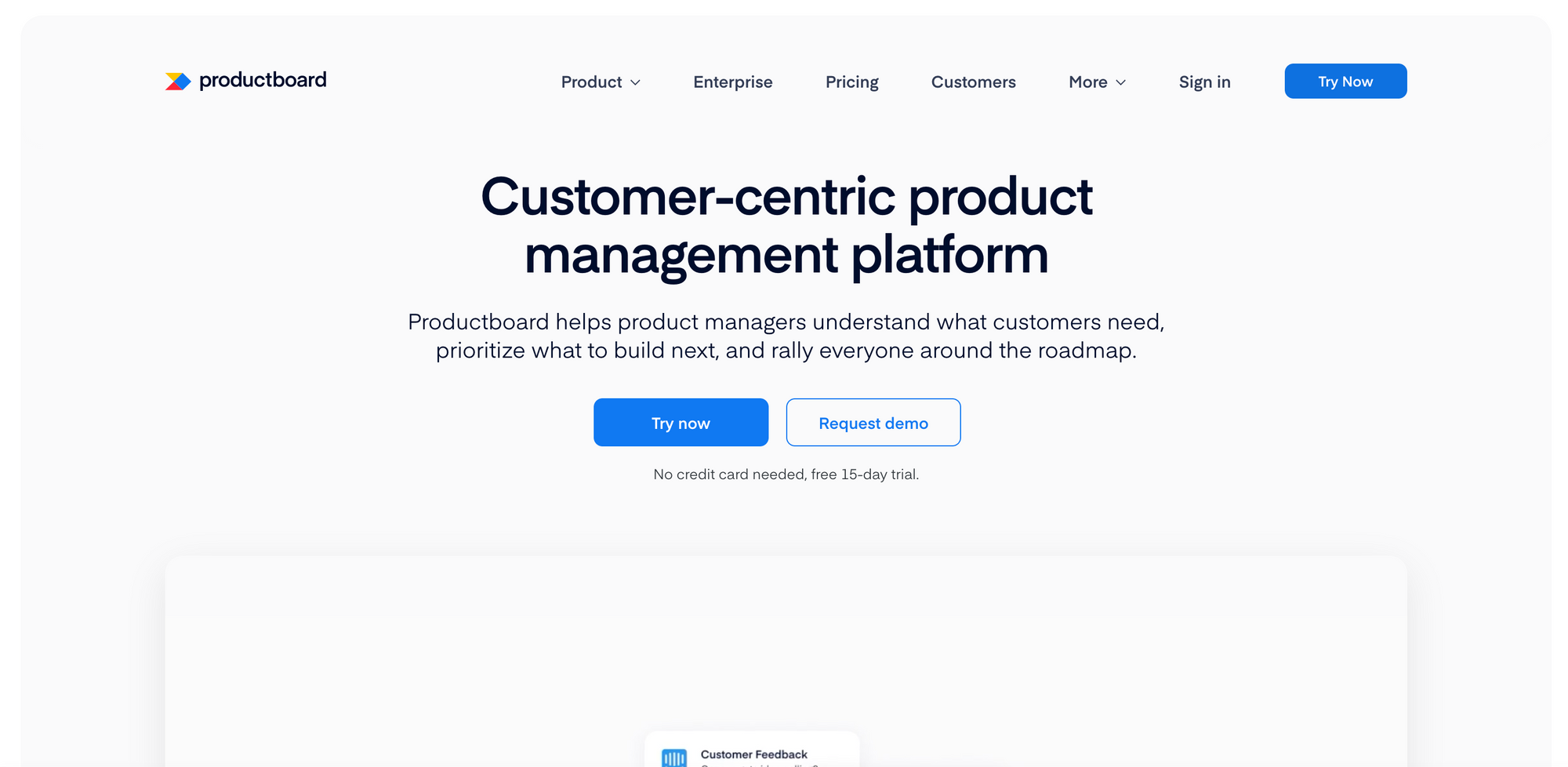
Pros of Productboard
- Productboard is a product management tool that combines a user feedback voting board with feature prioritization frameworks and roadmaps.
- Its key features include collecting feedback from email, prioritizing features with a set of frameworks, and various product roadmap templates.
- It supports integrations like Slack, Zapier, Help Scout, and Salesforce to manage projects and customer feedback.
- Productboard helps aggregate customer feedback, whether emails from customers, meeting notes, or feedback shared online, without letting any feedback get dropped.
Cons of Productboard
- Productboard feels like an overly complex product management tool. No doubt, it's great, consisting of all the customizations, but configuring the right setting for managing user feedback for you feels like a chore.
- It is less expensive compared to UserVoice; still, it's costly and has a per-seat pricing plan. At the time of writing, prices start from $25/month for one admin and five contributors with limited admin rights and restricted features compared to other feedback management tools.
Reviewers say that compared to UserVoice, Productboard is:
The good parts:
- Easier to administer.
- Better at support.
- Self-service.
- More integrations.
- Better designed.
The bad parts:
- More expensive.
- More focused on roadmapping.
4. Pendo
Pendo is an easy-to-use product analytics tool that provides great insights into customer behaviors. Pendo Feedback helps collect customer requests directly in your application without interrupting the product experience. Internal teams can also create requests on behalf of customers and submit their internal product feedback.
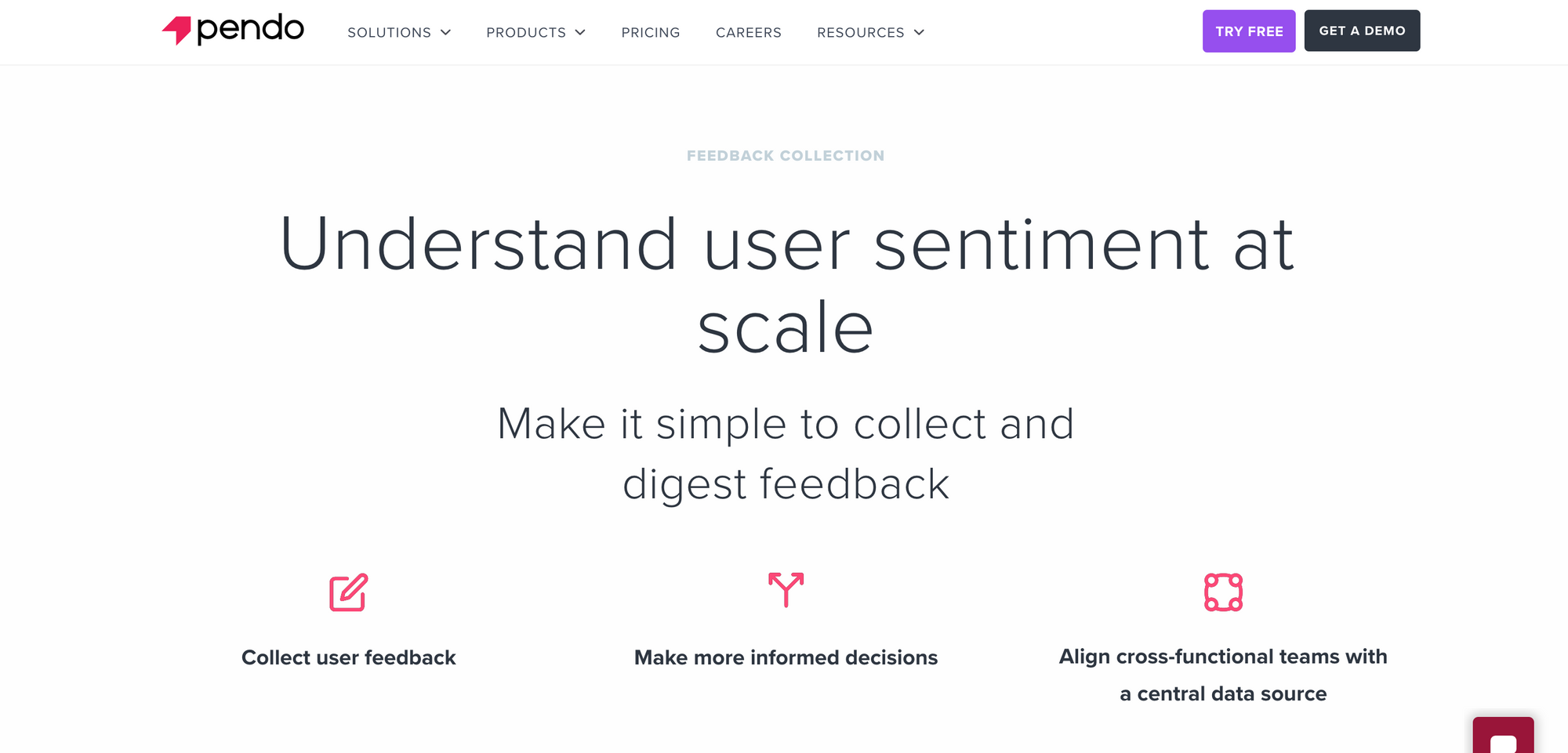
Pros of Pendo
- Pendo is an easy-to-use product analytics tool that tracks users' activity to understand how users use the product and helps product managers make important product decisions, track feature adoption, and monitor user behavior.
- Pendo makes it easy to track product KPIs, track usage across the platform, and assign users to different groups to track segment usage over time.
- Pendo feedback helps create a direct line between users and the product team to simplify feedback aggregation. It’s a comprehensive solution for user onboarding, analytics, and in-app user feedback.
Cons of Pendo
- Pendo's onboarding is lengthy and complex and only provides a few customization options without writing code or involving a developer.
- Pendo is an analytics tool first, a feedback tool later, and it shows. There is a huge learning curve with Pendo.
- It is a pricey deal with Pendo as compared to its alternatives. You need to contact a Pendo sales associate to get a custom plan and a price for your business, as they do not have pre-set pricing and are not self-serve.
Reviewers say that compared to UserVoice, Pendo is:
The good parts:
- It's easier to administer.
- Better at support.
- Modern design.
- Easier to track quantitative feedback.
The bad parts:
- More expensive.
- More focused on analytics.
- Not self-serve.
5. UseResponse
Rated: 4.3/5
UseResponse is an integrated customer support application that combines the functions of a support ticketing center, feedback communities, live chat, and knowledge database in a single package.
UseResponse helps companies improve customer support by introducing better customer self-service with the help of intelligent automation, chatbots, public communities, and embeddable knowledge base functionality.
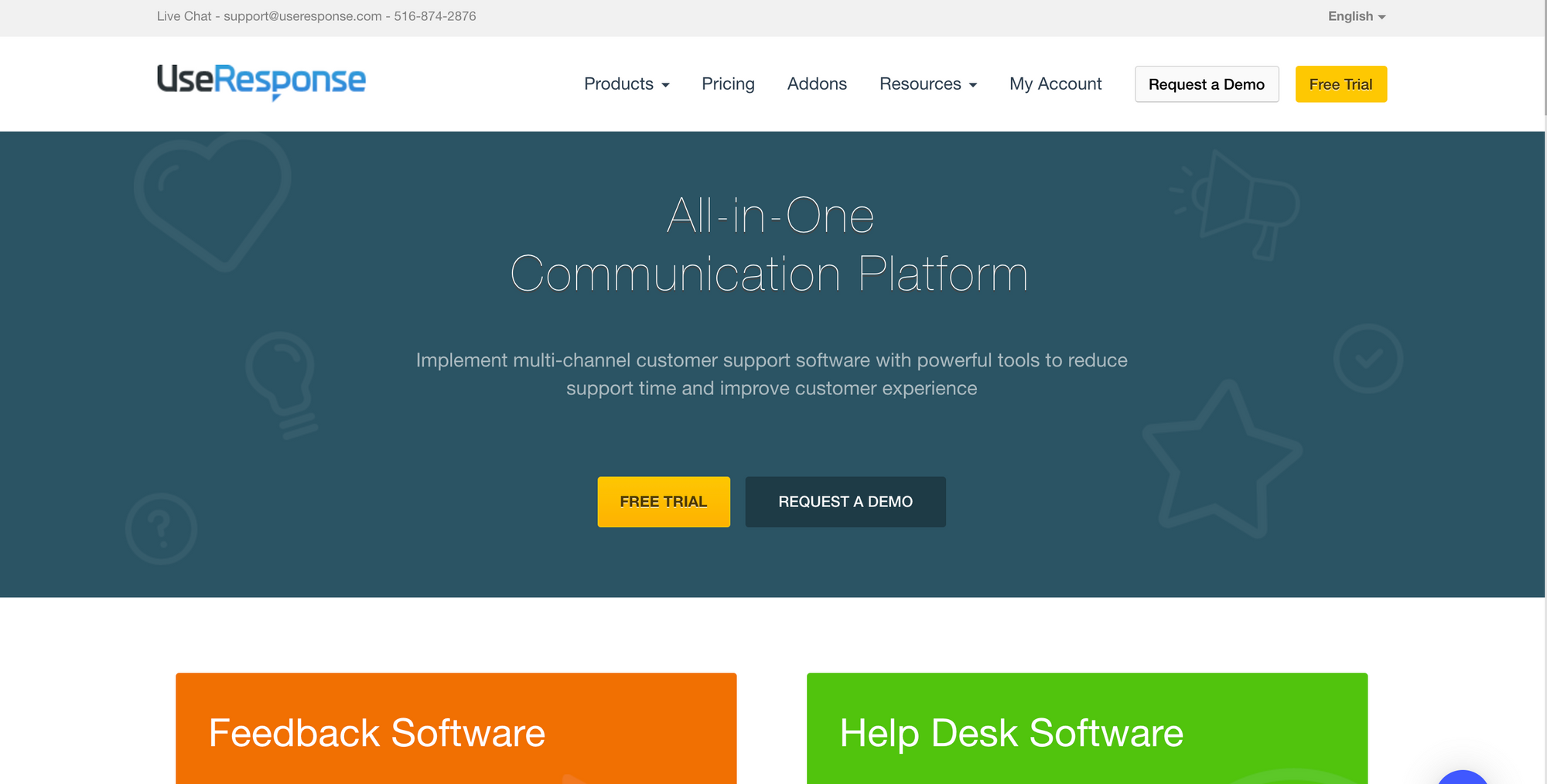
Pros
- UseResponse is a cloud-based support solution that provides users with customer service tools and feedback solutions.
- UseResponse helps companies improve customer support with the help of intelligent automation, chatbots, public communities, and embeddable knowledge base functionality.
- Their users say, "This company is customer-centric and tries to meet customer needs. Their customer support is always available and has a response time that is second to none."
Cons
- UseResponse can be complex and challenging to navigate as many functionalities exist.
- Difficult to customize and set up the tool.
- Reviewers say it's challenging to organize all the feedback in one place and customize the feedback dashboard in UseResponse.
- It is a pricey software with pricing starting at $124/month for two agents that offer all enterprise features.
Reviewers say that compared to UserVoice, UseReponse is:
The good parts:
- Self-service.
- Feedback, support, and knowledge base software in one.
- Simple, powerful, and customizable.
The bad parts:
- More focused on customer support.
- More expensive.
- Dated design.
- Lack of essential features like segmentation.
6. UserTesting
Rated: 4.5/5

Pros of UserTesting
- UserTesting is built to help you see the user in action: how they act and behave on your site.
- Action speaks more than words: video and screen recordings provide more in-depth data points to help you make actionable decisions and find usability holes in your product.
- Showing video clips of actual users is extremely helpful.
- It is simple, easy to use, and exposes a lot of nuances in user experience that would not be exposed through any other means.
Cons of UserTesting
- Recruiting for moderated testing costs more.
- It's more inclined toward usability testing and not customer feedback.
- It is designed specifically for testing, not for collecting feedback. It requires planning and more time than other methods, such as surveys.
- Watching videos can be long and tedious.
Reviewers say that compared to UserVoice, UserTesting is:
The good parts:
- Better at support.
- Simple, powerful, and customizable.
- Modern design.
The bad parts:
- More focus on testing.
- More expensive.
- Lack of essential features for feedback forum.
7. ProdPad
Rated: 4.3/5
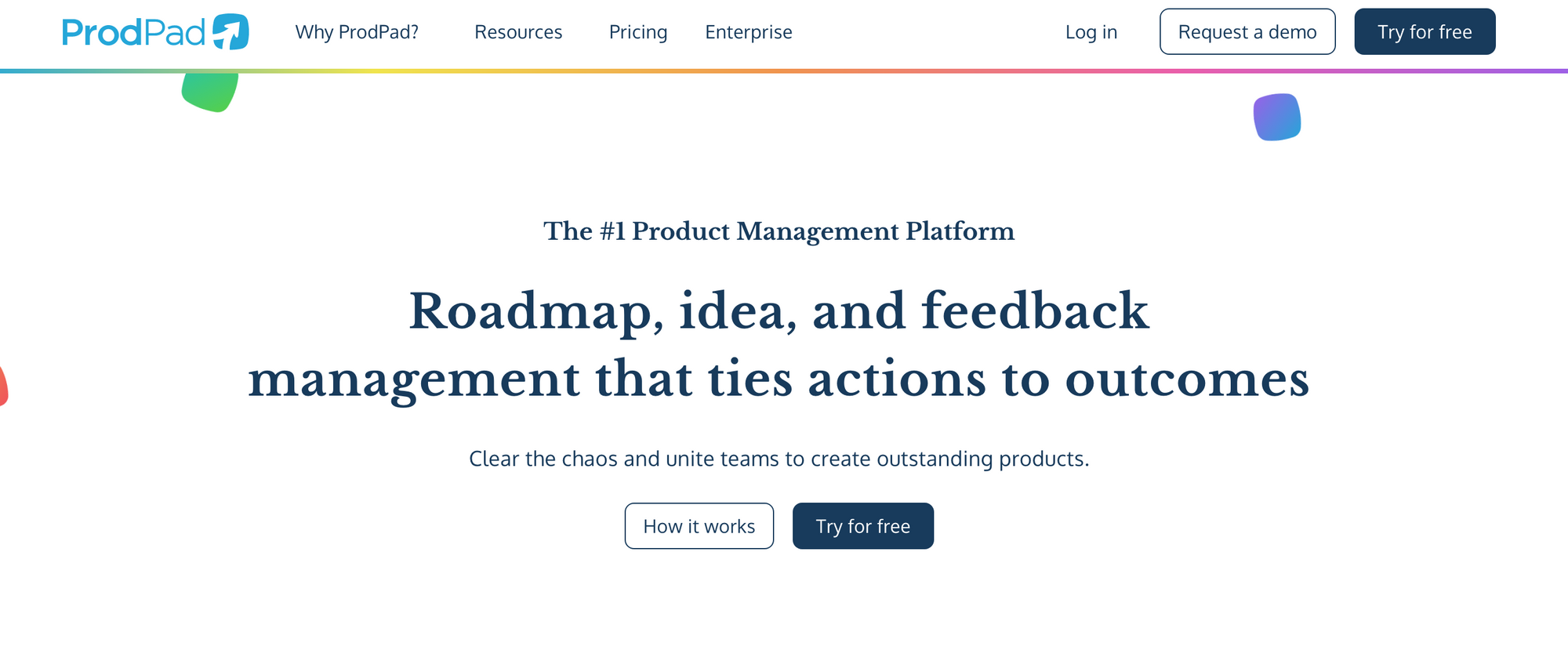
ProdPad is a product feedback and road-mapping tool where product teams can share feedback about the product, and upvote features with a feature voting board. It helps create a neatly structured public roadmap for multiple products with a timeline view that showcases the updated announcements of a particular product.
Pros of ProdPad
- The tool seems easy to use and supports the ability to build roadmaps to communicate with both engineers & executives at the same place.
- It also allows users to create multiple ideas and feedback that can be later used based on priorities. Users love the visualization charts inside the tool, which help teams prioritize projects better.
- Its interface has a reasonably intuitive design that allows users to perform multiple tasks and activities relatively quickly.
- ProdPad helps customers to visualize, collaborate, and easily maintain their roadmaps in one place, replacing spreadsheets.
Cons of ProdPad
- Users complain that it's challenging to browse through all the customer feedback and feature ideas in the software using search, and scanning through duplicates is also inconsistent with product updates. It needs external tools to utilize the client feedback feature entirely compared to its alternatives.
- ProdPad has a steep learning curve and can be overwhelming for new users.
- Their pricing model seems different as they don't charge per individual seat but on bundles of seats that work out to $50 per user.
Reviewers say that compared to UserVoice, ProdPad is:
The good parts:
- Easy to use.
- Simple, powerful, and customizable.
- Modern design.
The bad parts:
- Overwhelming for new users.
- Harder to set up.
- Lacks proper customer support.
8. ProductPlan
Rated: 4.6/5
ProductPlan is an easy-to-use roadmapping software that helps teams plan, visualize, and share the product feedback strategy. Create beautiful, collaborative roadmaps in minutes.
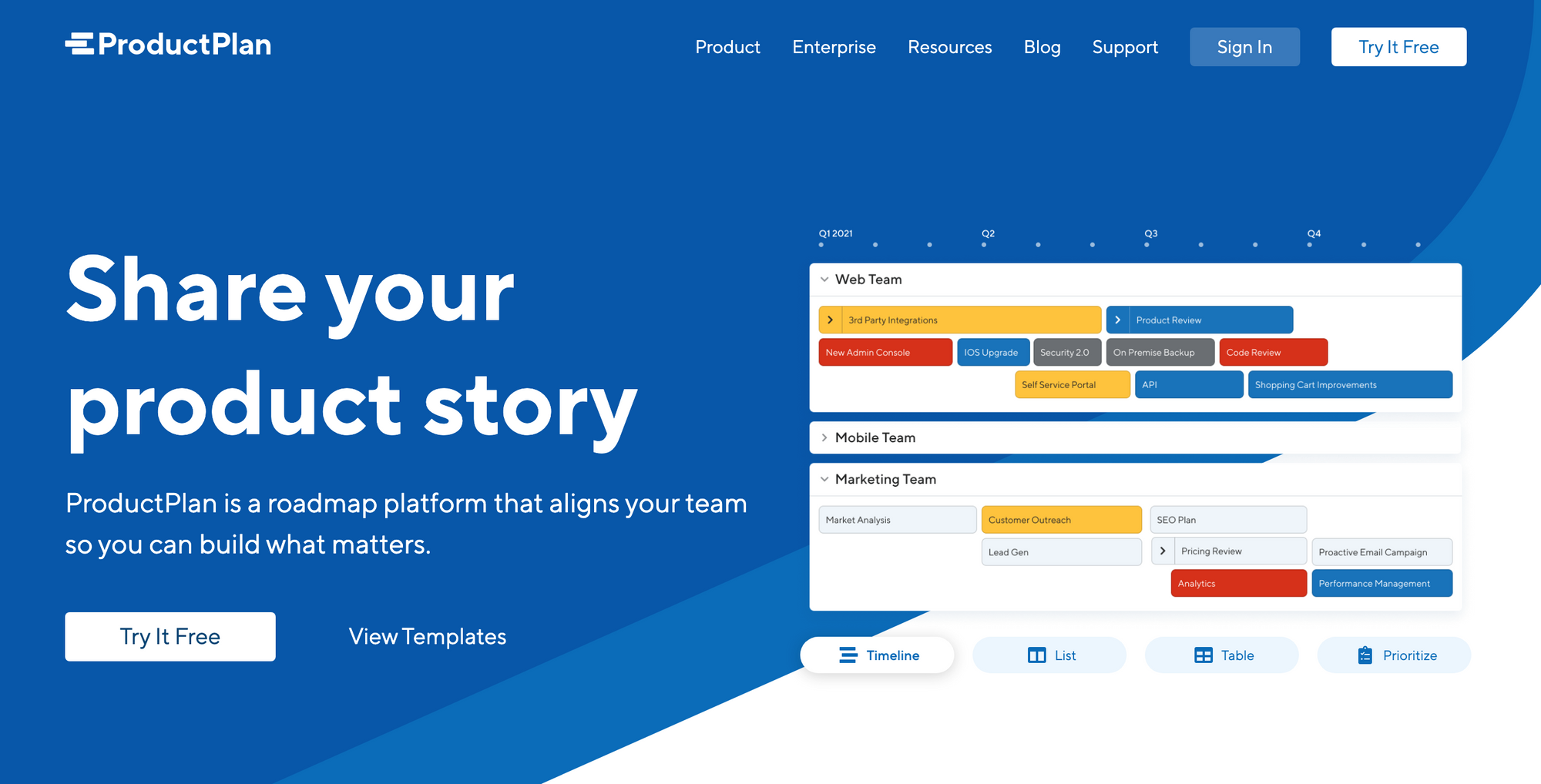
Pros of ProductPlan
- ProductPlan easily supports creating and updating roadmaps with a strong level of detail - the filtering capabilities also ensure we can share relevant roadmap details with the people who need them.
- One of their customers quoted," ProductPlan makes all work within the company more agile and simple, allowing working time to be more valued and without any setbacks."
- It helps provide all stakeholders visibility into a company's development roadmap, knowing what is currently being worked on and what is coming up in the pipeline.
Cons of ProductPlan
- ProductPlan is a product management software first, not developed for feedback management, lacks product feedback boards, changelogs, and custom status, and requires extra payment for features like SSO.
- It accomplishes its core goal of visualizing a product roadmap, but it's hard to collaborate with teams, as not everyone has a paid account, so only one or two people can update the roadmap.
- The cost can be a little higher for small companies, limiting the use capacity for those who need it and can not afford a tool like this.
Reviewers say that compared to UserVoice, ProductPlan is:
The good parts:
- Easy to set up.
- Simple and modern design.
The bad parts:
- Missing important features.
- Lacks proper customer support.
9. Mopinion
Rated: 4.1/5
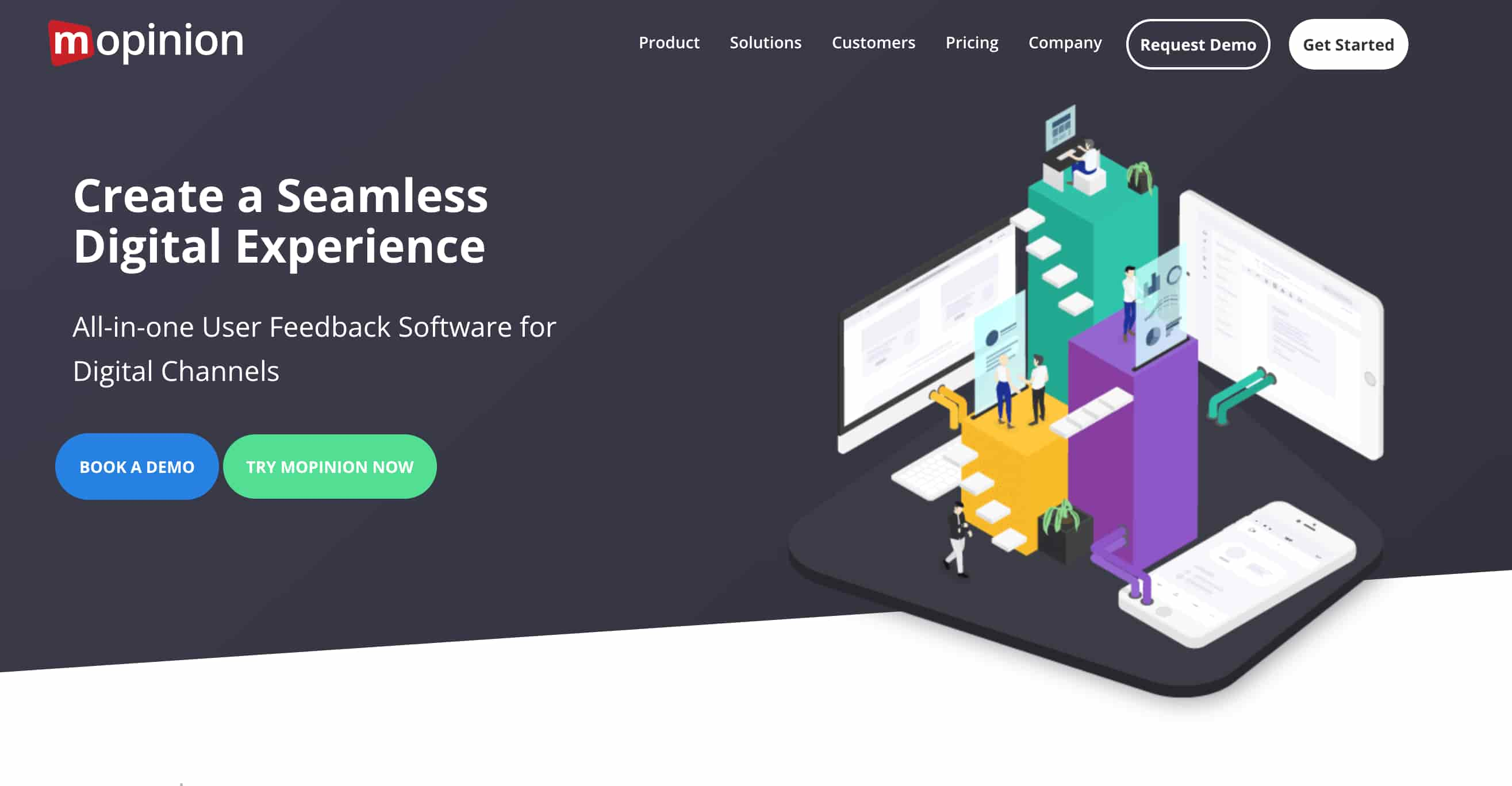
Mopinion empowers its users to create customizable online feedback forms, including various CX metrics such as NPS, CES, and CSAT, and trigger them based on rules such as mouse movement, exit intent, and more.
Pros of Mopinion
- It allows you to create, design, and configure feedback forms and embed them directly into the site.
- It also offers reporting, analytics, and sentiment analysis to gauge customer sentiment.
- Mopinion also helps you collect and organize customer feedback across multiple channels, including in-app feedback.
- It also supports customer segmentation to target selected customer demographics.
Cons of Mopinion
- Being expensive, with plans starting at $229/month, it is unsuitable for startups and small businesses compared to its alternatives.
- It doesn't support feature request voting boards like Rapidr.
Reviewers say that compared to UserVoice, Mopinion is:
The good parts:
- Modern design.
- Offers sentiment analysis.
The bad parts:
- Majorly supports feedback forms.
- Lacks support for feature voting.
10. Qualaroo
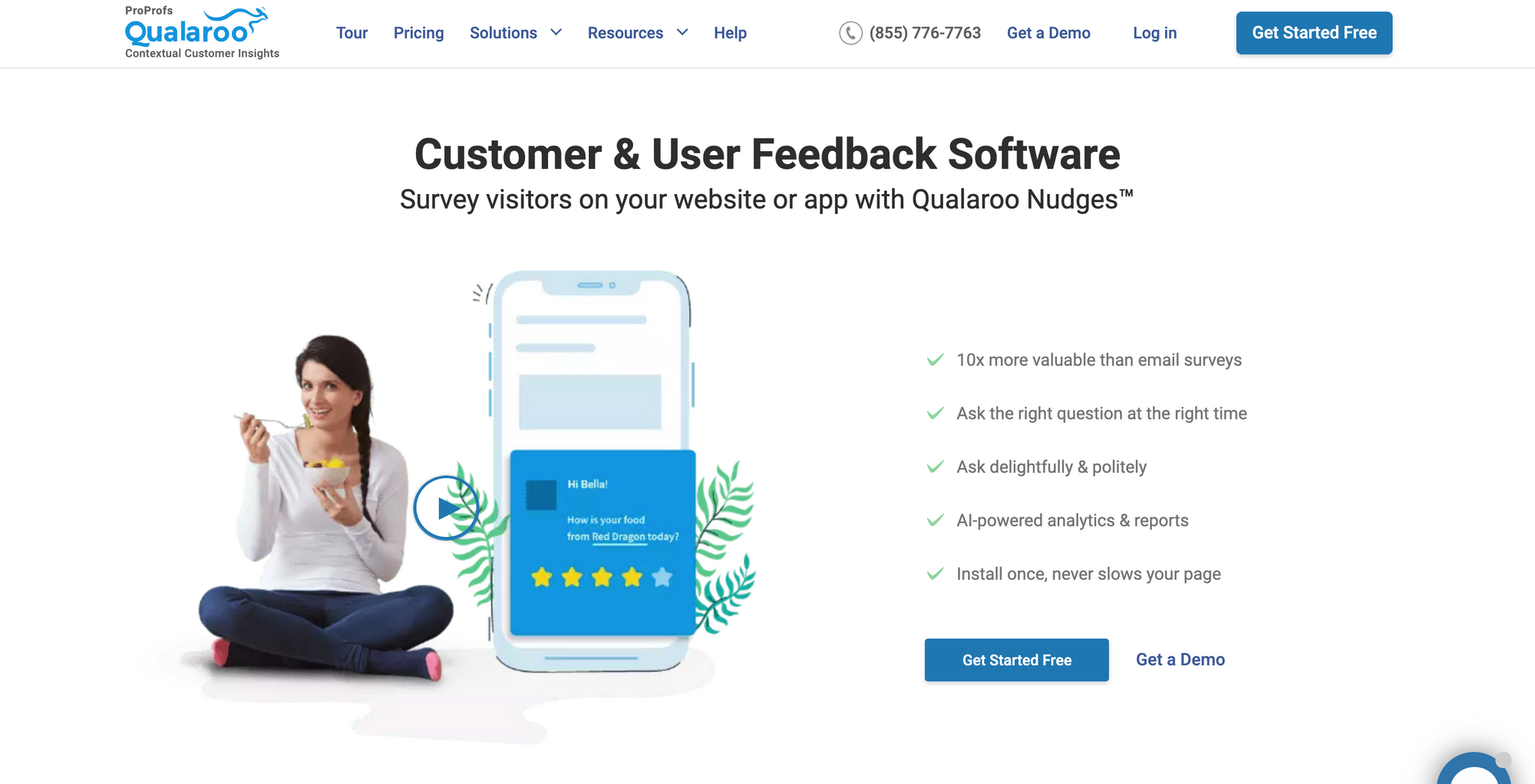
Qualaroo is a survey feedback platform that helps to gain qualitative insights through website surveys. Its key features include sentiment analysis, cookie targeting, data streaming, custom properties, and responses.
Pros of Qualaroo
- The platform provides a proprietary insight or bug-capture tool that helps you ask the right questions at the right time
- Qualaroo helps users engage with customers based on their actions on the website and segments customers similarly to Rapidr.
- It also allows personalization by adding skip logic and templates to create surveys and open-ended questions to gather free-form feedback.
Cons of Qualaroo
- This is your best bet if you are looking for an advanced survey tool. Still, a customer feedback management tool requires collecting, prioritizing, and managing feedback under one roof to close the feedback loop, and Qualaroo doesn't have the necessary features to do that.
- It is expensive, with plans starting at $100 per month. Customers quote the price of the tool to be on the higher side as compared to its alternatives.
Reviewers say that compared to UserVoice, Qualaroo is:
The good parts:
- Easy to set up.
- Supports open-ended feedback surveys.
- Provides sentiment analysis.
The bad parts:
- Mainly a customer feedback survey tool.
- Missing feedback management features.
11. Hotjar
Rated: 4.4/5
Hotjar is a game-changing analytics tool for page view and user session recordings. It offers analysis and feedback, including Heatmaps, Conversion Funnels, Form Analytics, and Visitor Recording. With these analysis tools, companies can monitor and measure user behavior. In addition, Hotjar provides visual representations of website visitors and their usage behavior.
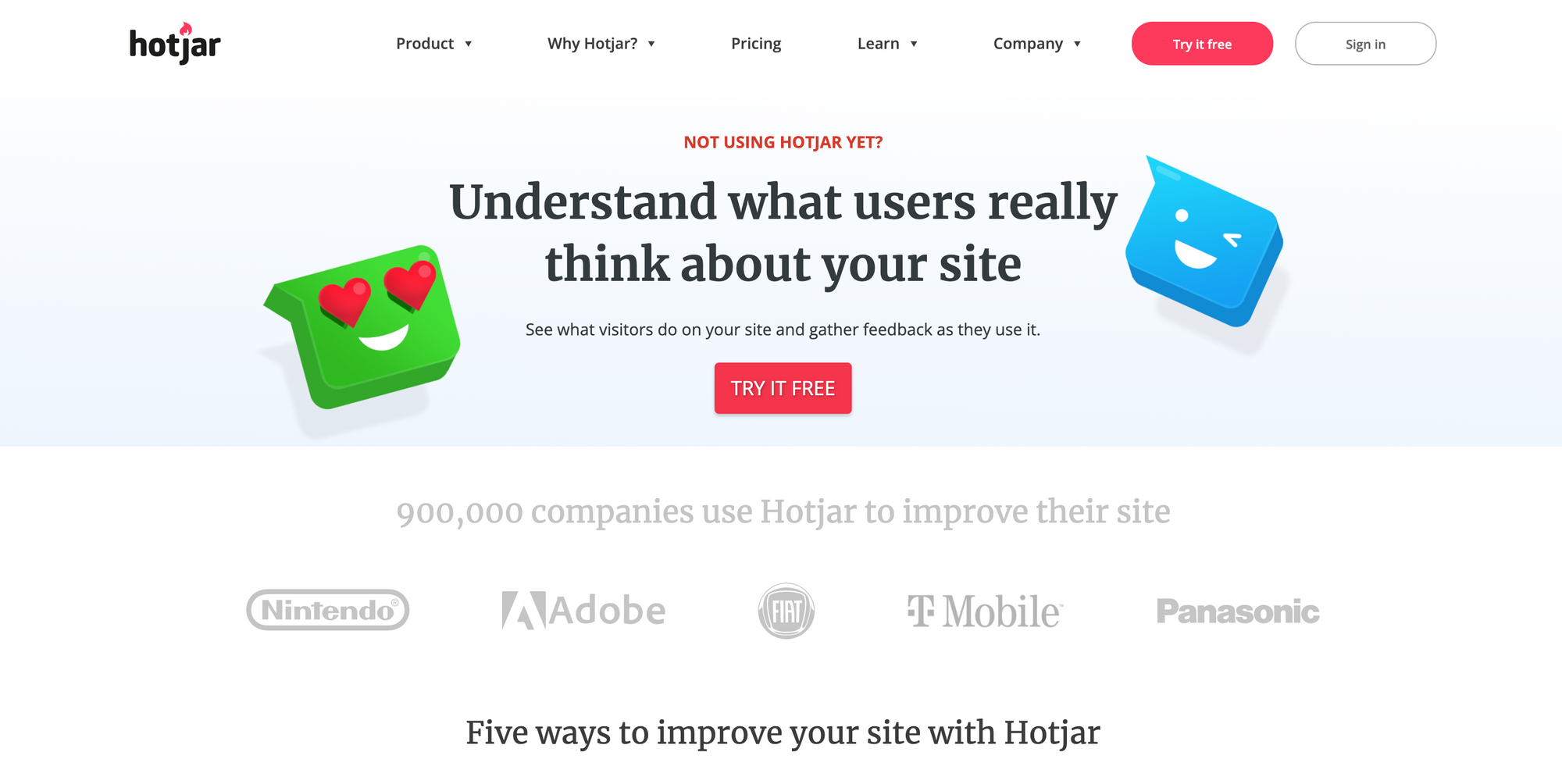
Pros of Hotjar
- Hotjar has a user-friendly user interface. It's lightweight and straightforward to use, doesn't go overboard with complicated functionality, and is robust enough to provide critical insights.
- Hotjar helps you track customer journeys on your website to improve your customers' onsite experiences and engagements. Hotjar provides its data as visual representations called heatmaps.
- They add a tab or feedback widget on your website where users can click to leave comments. This gives people a way out if they face problems and provide feedback.
- Hotjar's key selling point is packing analysis and feedback in one platform. Understanding your users enables you to ask for their feedback instead of doing guesswork directly.
Cons of Hotjar
- Hotjar is an analytics tool with heatmaps, but feedback is an afterthought. It is more focused on analytics and user behavior rather than being a full feedback solution.
- Hotjar does not have a voting mechanism or a feedback portal compared to its alternatives.
- Hotjar lacks the functionality of the group and keeps track of similar feedback and ways to categorize the feedback received to make sense of it. They do not provide an exclusive feedback-focused dashboard, just polls and surveys to collect feedback as Rapidr does.
Reviewers say that compared to UserVoice, Hotjar is:
The good parts:
- Better at support.
- Self-service.
- Session replay and heatmap built-in.
- Cost-effective.
- Modern design.
The bad parts:
- More focused on heat mapping and session replays.
12. Podium
Rated: 4.3/5
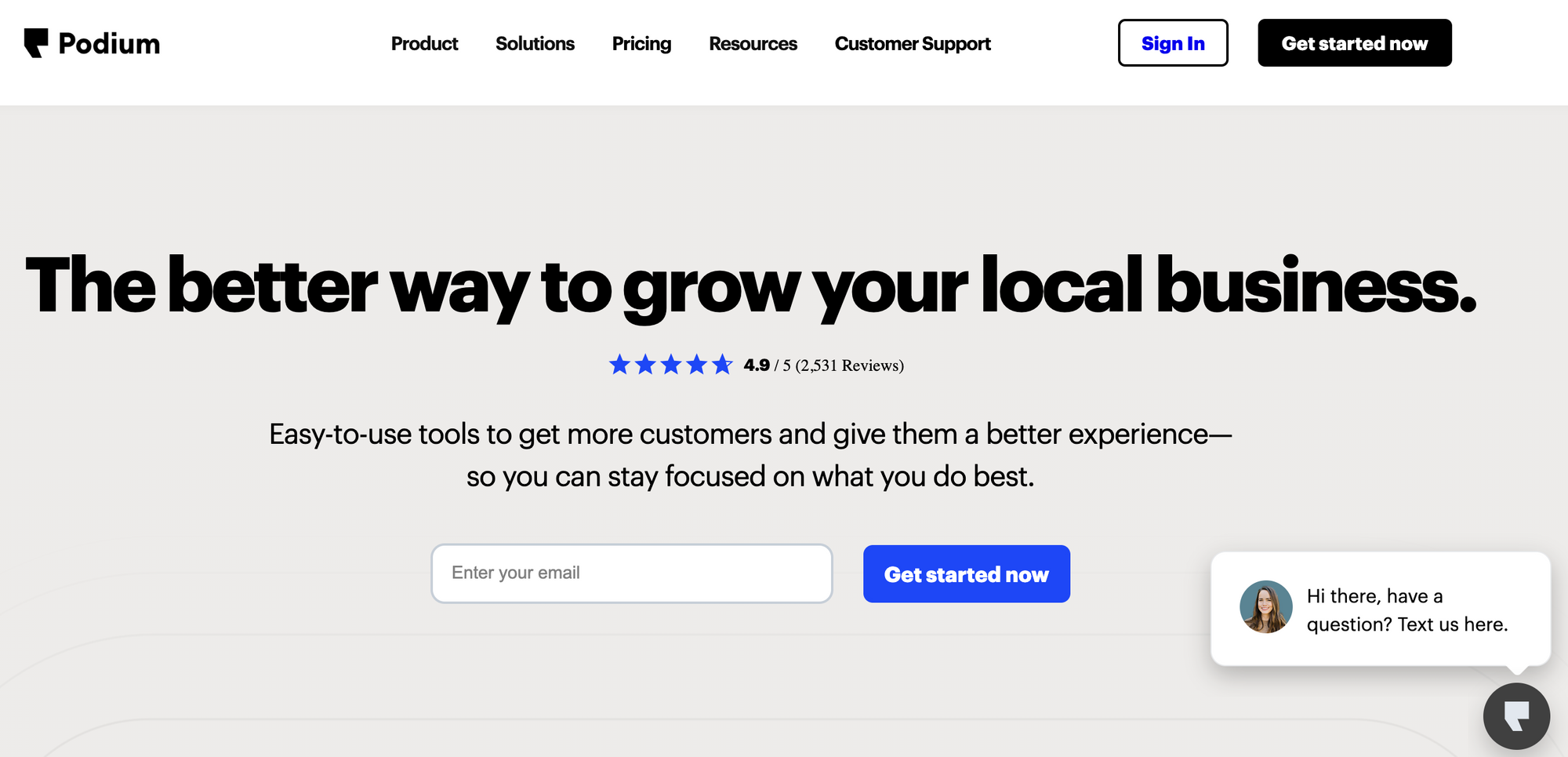
Podium is a reputation management and messaging platform that allows collecting reviews on the sites, gathering private feedback after an experience, and managing all your customer messages from one central dashboard with an inbox.
Pricing: Contact for a custom quote. Starts at $500 a month
Use Case: Best for reputation & customer experience management
Pros of Podium
- Podium helps you message your customers, get reviews and feedback, collect payments, and communicate easily with your team.
- The UI is easy to use and simple to learn. Anyone can grasp the software quickly and get up and running fast. Customers mentioned great ease of use.
- Podium allows you to keep in touch with your clients at all times. It is quoted to be easy to use and helpful in communicating with clients.
Cons of Podium
- Being a chat and messaging tool, it is more focused on enhancing customers' experience and clarifying their doubts whenever they are stuck somewhere, but not so great when collecting and managing their feature requests or any product-related insights.
- Closing the user feedback loop feels hard as there are no timely notifications for updates, and their notification system seems clunky.
Verdict: Rapidr is the Best UserVoice Alternative
For growing product teams, you must decide on a tool to make your customer feedback management process a piece of the cake. Everything should go hand-in-hand, from collection to analyzing and prioritizing to releasing software.
Each solution presented here is unique and has a different feature set, which caters to varying use cases that you can't go wrong with as an affordable alternative to UserVoice.
We recommend Rapidr as the best UserVoice alternative, which comes with a modern design and tightly nit feature set that stacks fairly well against UserVoice, offers a clean user experience, and has cost-effective pricing plans. Get started now.
FAQs
1. What are the top UserVoice alternatives for product management?
Top 12 UserVoice Alternatives and Competitors are Rapidr, Aha, Productboard, Pendo, UseResponse, UserTesting, Prodpad, ProductPlan, Mopinion, and Qualaroo, Hotjar, Podium.
2. Who is the #1 UserVoice alternative?
Rapidr is the #1 UserVoice alternative, which comes with a modern design and tightly nit feature set that stacks fairly well against UserVoice, offers a clean user experience, and has cost-effective pricing plans
3. How does UserVoice compare to Rapidr?
Rapidr is an easy-to-use and affordable customer feedback management tool that helps product managers complete the user feedback lifecycle, compared to UserVoice, which is expensive, complex, and bloated with features.
Rapidr is an end-to-end feedback solution, so you don't have to glue multiple apps together. You get feedback collection, roadmapping, and release notes software with it. Get started now.

